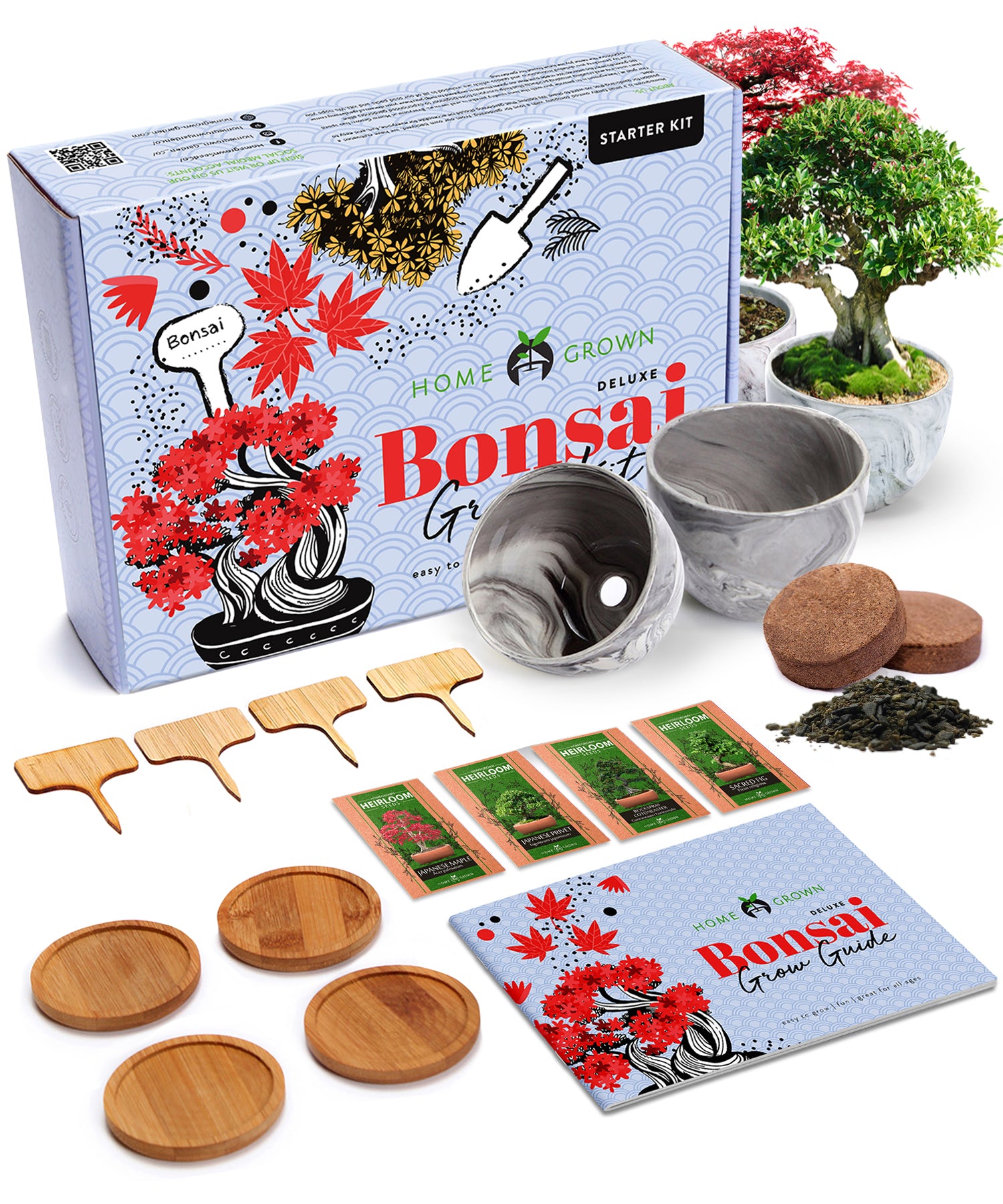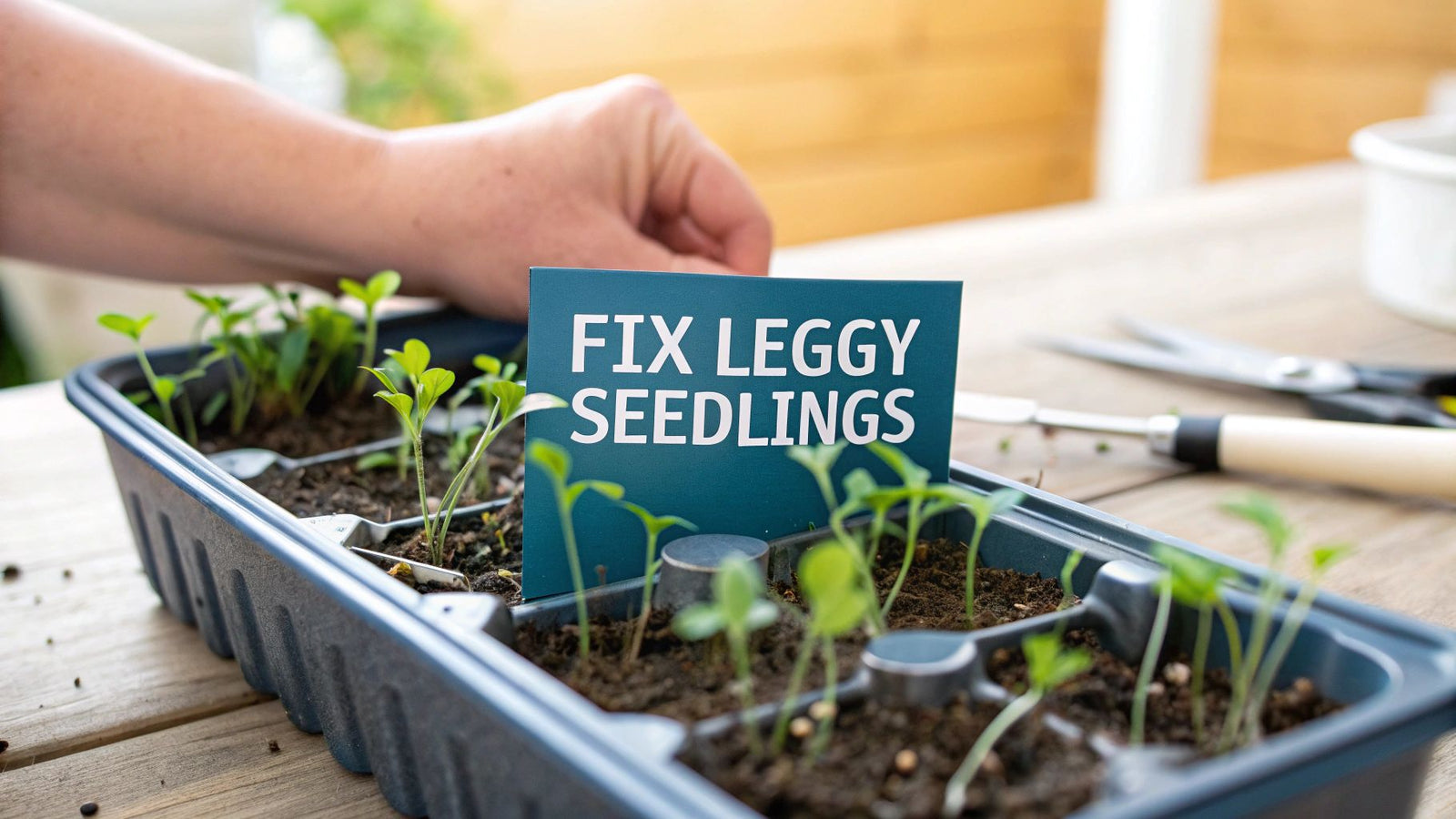
So, you've got leggy seedlings. Don't panic! It happens to even the most seasoned gardeners. Those long, spindly, and pale stems are just your baby plants' dramatic way of screaming for one thing: more light.
Think of it as their first big survival test. They’re desperately reaching for a better light source, a process botanists call etiolation. While it's a clever survival instinct, this rapid, weak growth makes them fragile and susceptible to toppling over or getting sick.
The good news? It’s a completely fixable problem, and usually, you can turn things around pretty quickly. The key is to act fast and make a few simple adjustments to their environment. This is basically plant first aid.
We'll get into the step-by-step rescue mission, but first, let's quickly diagnose what's going on.
Common Causes of Leggy Seedlings and Their Quick Fixes
Sometimes you just need a quick diagnosis and an immediate fix. This table breaks down the most common reasons your seedlings are stretching and tells you exactly what to do about it right now.
| Problem (The Cause) | Symptom | Quick Fix Solution |
|---|---|---|
| Insufficient Light | Long, pale, thin stems that lean heavily toward a light source. | Move seedlings much closer to the light source (1-3 inches from a grow light) or switch to a stronger light. |
| Excessive Heat | Rapid, weak vertical growth, especially after germination. | Remove heat mats and humidity domes as soon as most seeds have sprouted. Lower the ambient temperature. |
| Overcrowding | Multiple seedlings in one cell stretching to compete for light. | Thin seedlings to one strong plant per cell or pot to eliminate competition. |
| Poor Airflow | Flimsy stems that cannot support themselves. | Use a small oscillating fan on a low setting for 1-2 hours daily to simulate a natural breeze and strengthen stems. |
Once you've put out the immediate fire using one of those quick fixes, we can dig into the more detailed strategies to not only save your current seedlings but prevent this from ever happening again.
1. Give Your Seedlings Stronger, Closer Light
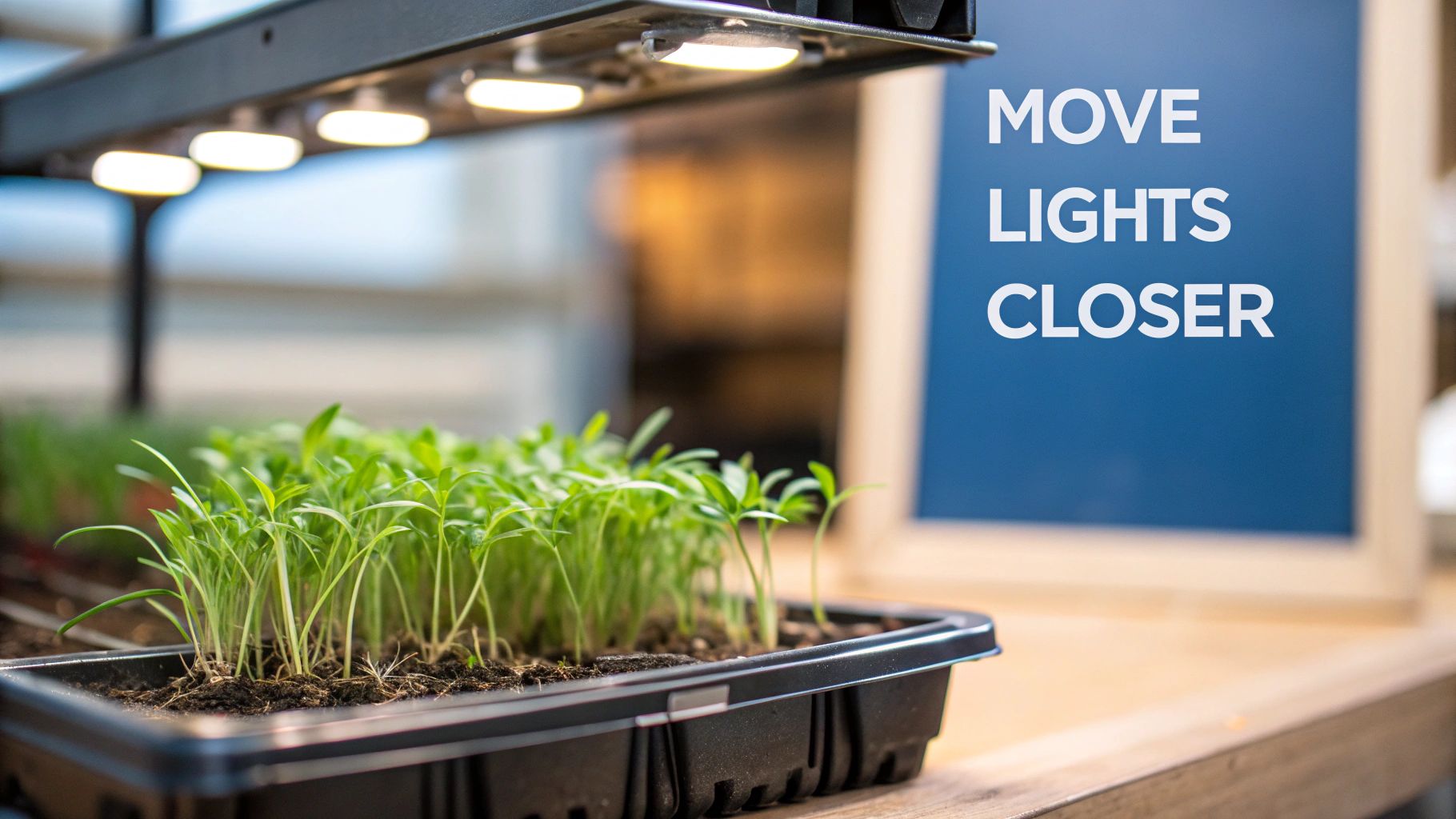
If your seedlings look like tiny green giraffes, stretching desperately for the sky, the problem is almost always a lack of intense, direct light. This spindly growth is a survival instinct called etiolation. The plant is literally searching for the energy it needs to grow strong, and a sunny windowsill just won't cut it, especially during the short days of late winter and early spring.
In my experience, weak light is the reason behind roughly 95% of all leggy seedling issues. To get those sturdy stems and healthy leaves, your baby plants need a powerful, consistent light source right overhead.
Get Your Lights in the Right Position
The most common mistake I see gardeners make is hanging their lights way too high. To stop the stretching, your seedlings need to be surprisingly close to the bulbs—think inches, not feet.
- Fluorescent shop lights: Keep these bulbs just 2 to 4 inches from the tops of your seedlings. Yes, that close!
- Modern LED grow lights: These can usually be a bit further away, about 4 to 6 inches, but it's always smart to check the manufacturer's guidelines first.
You'll need to adjust the lights as your seedlings grow. I find using simple adjustable chains makes this a breeze, allowing you to raise the fixture every few days to maintain that perfect distance.
My Favorite Hack: If you don't have an adjustable light, just prop up your seedling trays instead. Use a stack of books, woodblocks, or even upside-down pots to get them closer to the light. As the plants get taller, you just remove a book or a block. Easy.
Pick the Right Kind of Light
A south-facing window might seem bright, but it rarely provides the 12 to 16 hours of consistent, direct light that young plants really need to thrive. Artificial lighting is your most reliable bet for preventing and fixing legginess.
Here’s a quick rundown of the go-to options:
- Fluorescent Lights: These are the classic, budget-friendly choice. Standard T5 or T8 shop lights do a fantastic job and provide a good light spectrum for new growth.
- LED Grow Lights: While a bigger investment upfront, LEDs are more energy-efficient and run much cooler. This means you can get them super close without worrying about scorching your delicate seedlings. Plus, many offer a full light spectrum designed specifically for plant growth.
Investing in a dedicated grow light is probably the single biggest upgrade you can make to your seed-starting setup. If you want to dive deeper, check out our guide on the best grow lights for seed starting, where we break down the best options out there.
2. Manage Post-Germination Temperature and Humidity
It’s easy to create the perfect storm for leggy seedlings without even realizing it. Those heat mats and humidity domes are fantastic for coaxing seeds to sprout, creating a warm, cozy little nursery. But here’s the thing many gardeners learn the hard way—once the germination party starts, you have to turn down the heat.
Keeping these tools running long after your seeds have sprouted is one of the most common mistakes I see. It encourages weak, rapid stem growth. All that extra warmth and humidity tells the plant to shoot upward as fast as it can, but it completely forgets to build the sturdy stem needed to support itself.
When to Remove the Dome and Heat Mat
That moment your seedlings switch from just sprouting to actively growing is critical. Your job is to pull back those "incubation" conditions at just the right time, signaling your tiny plants that it’s time to toughen up.
The rule of thumb I follow is to remove the humidity dome and switch off the heat mat once about 80-90% of your seeds have sprouted. If you leave them on any longer, you're just creating a spa for flimsy stems and inviting fungal diseases like damping off, which thrive in moist, stagnant air.
Key Takeaway: Heat and humidity are for sprouting, not for growing. The second you see a good amount of green, it’s time to change the environment to promote strong, compact growth instead of lanky, weak stems.
Creating the Ideal Growing Environment
After that dome comes off, your seedlings need a slightly cooler and less humid world to really thrive. This shift in conditions naturally slows down that frantic vertical growth and encourages the plant to put its energy into developing a stronger stem and a more robust root system.
Getting these environmental conditions right is a huge part of knowing how to fix leggy seedlings before the problem gets out of hand. In fact, prolonged warmth and humidity are a primary cause of etiolation (the technical term for all that stretching). This is where something like our seed germination temperature chart comes in handy, as it helps you understand the specific needs of what you’re growing.
From my own experience and what I've seen from other gardeners, seedlings kept under domes too long are far more likely to get leggy. Some growers report over 70% higher mortality rates or poor transplant success. If you want to dig deeper into how the environment affects your seedlings, check out these insights from Rural Sprout.
Here’s a quick checklist to guide you through the post-germination phase:
- Temperature: Aim for a cooler room temperature, somewhere between 65-75°F (18-24°C). This moderate range is the sweet spot for sturdy growth.
- Humidity: Taking the dome off will naturally drop the humidity. From here on out, good airflow is your best friend.
- Light: This is the moment light becomes absolutely essential. Get those sprouted seedlings immediately under a strong, close light source, just as we covered in the previous section.
By taking control of temperature and humidity right after your seeds sprout, you can head off one of the biggest causes of weak, spindly plants. You're setting your seedlings up for a strong, healthy life from day one.
3. Rethink Your Watering and Spacing
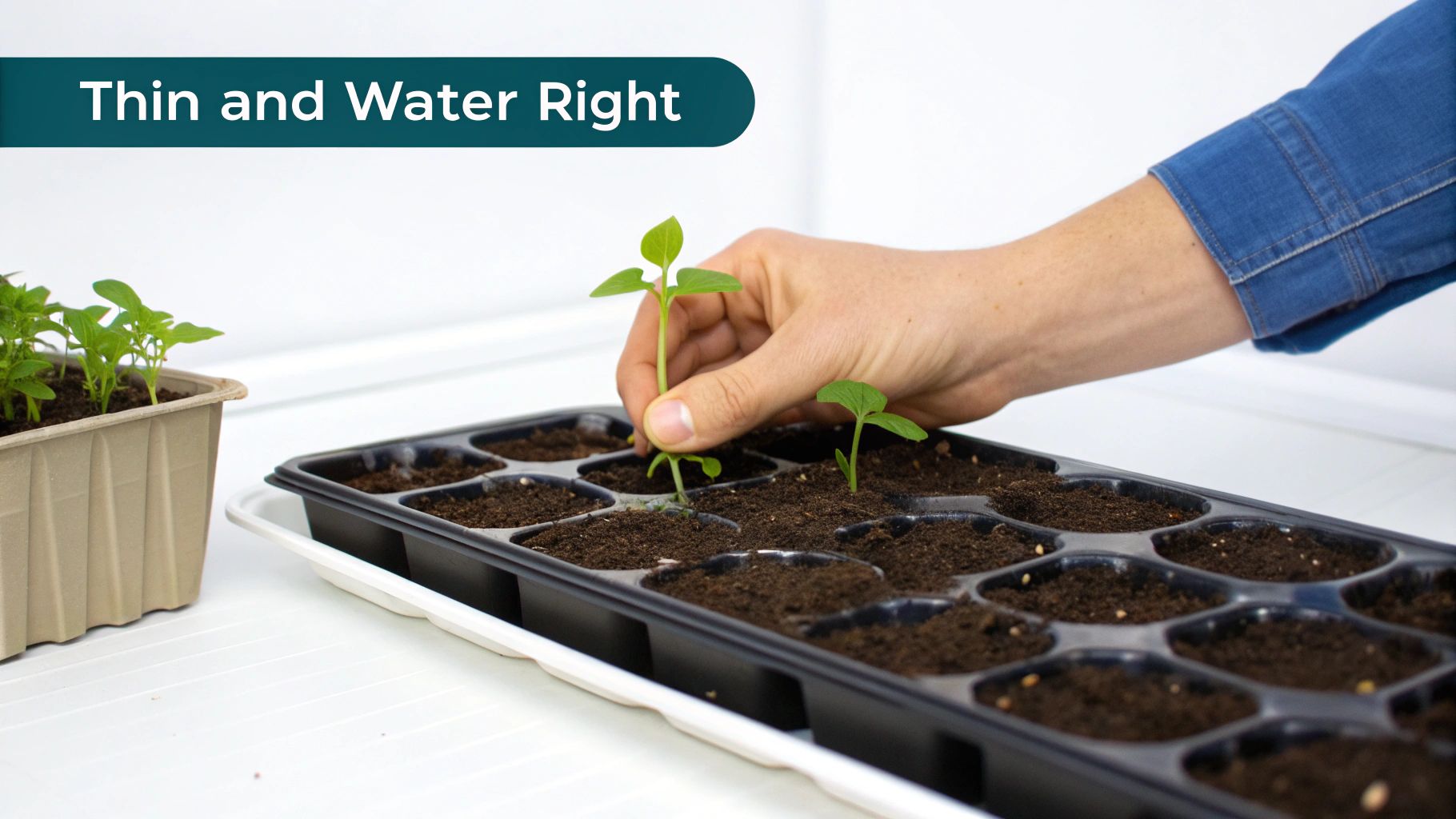
We often point the finger at light and temperature for leggy seedlings, but two other sneaky culprits are often to blame: overcrowding and how you water.
When you sow seeds too densely, you're setting up a miniature battle royale. All those baby plants are forced to compete for light, space, and food. This triggers a survival instinct to grow tall—fast—to get above the competition, leading straight to those weak, spindly stems we all hate.
Your watering habits can also make or break your seedlings. Drenching them from above seems easy, but it often compacts the soil, invites fungal diseases like damping-off, and encourages the roots to get lazy and stay shallow. A strong plant needs a deep, robust root system, and that starts from day one.
Give Them Some Breathing Room
It feels a bit brutal, I know, but thinning your seedlings is one of the most important jobs you'll do. By snipping away the weaker contenders, you ensure the strongest one in each cell gets all the resources it needs to thrive. No more competition.
The best time to do this is when the seedlings have developed their first set of true leaves (that's the second pair of leaves to appear). Grab a small pair of scissors and snip the weaker ones right at the soil line. Never pull them out! Yanking them can easily damage the delicate roots of the neighbor you’re trying to save.
Master the Art of Bottom-Watering
If you want to build strong root systems and prevent weak stems, bottom-watering is a complete game-changer. It’s exactly what it sounds like: letting the seedlings soak up water from a tray below instead of pouring it over the top. This simple trick encourages the roots to grow downward, seeking out moisture. The result is a deep, extensive root network that creates a strong, stable plant.
Why It Works: Bottom-watering keeps the top layer of soil relatively dry, which dramatically cuts down the risk of fungal problems. It also prevents the soil from getting packed down, allowing precious oxygen to reach the roots. A healthy root system is the foundation for a stocky, resilient plant.
Setting it up is easy. Just place your seedling cells or pots (make sure they have drainage holes!) into a solid tray without holes. Pour about an inch of water into the outer tray and let your seedlings sit for 15-30 minutes. You'll know they're done when the soil surface looks moist. Once they've had a good drink, take them out of the tray and let any excess water drain away.
Proper spacing and watering are non-negotiable for preventing legginess. Overcrowded seedlings are in a constant, stressful race for light, and inconsistent watering only makes it worse. In fact, experts estimate that getting your thinning and watering right can cut transplant failure from legginess by up to 30%. Techniques like bottom-watering are so effective because they deliver consistent moisture where it's needed most—at the roots.
To dig deeper into this, check out this excellent guide on how to prevent and fix leggy seedlings.
4. Toughen Them Up with a Gentle Breeze
Out in the wild, seedlings are constantly dealing with the wind. This gentle, persistent challenge forces them to develop thick, sturdy stems to avoid getting knocked over. Our indoor-grown seedlings? They often live a sheltered, wind-free life, which is a big reason they can get so flimsy and weak.
The good news is we can easily replicate this natural "stress" to build much tougher plants. It’s a great way to fix leggy seedlings before they get too fragile, signaling to the plant that it needs to bulk up its foundation instead of just stretching for the sky.
One of the best and easiest ways to do this is with a small, oscillating fan. You're not trying to create a windstorm in your grow room; the goal is a light, indirect breeze that mimics what they'd feel outdoors.
- Set your fan to its lowest speed and position it a few feet away from your seedlings.
- Run it for about 1-2 hours a day. That’s all it takes for the gentle motion to encourage the stems to flex, which strengthens them over time.
- As a bonus, this improved air circulation helps dry the soil surface, which is a great way to ward off fungal problems like damping-off.
Thinking about the bigger picture of air movement is also helpful. Understanding the basics of maximizing airflow in a space can create a healthier environment for your plants long after they've left the seedling tray.
5. Simulate Wind by Brushing Seedling Tops
No fan? No problem. If you're working with just a few trays or in a tight space, you can simulate the same effect by hand. It sounds almost too simple to be true, but it really works.
Just run your hand gently over the tops of your seedlings a few times whenever you check on them. This light physical touch tricks the plant into thinking it’s being buffeted by the wind. In response, it triggers a hormonal change that tells the stem to grow shorter and stronger.
The key here is to be gentle. You just want to brush the very tops, not bend or damage the stems. A few passes back and forth, maybe 10-15 times a day, is more than enough to see a real difference in how thick and sturdy the stems become.
6. Repot Leggy Seedlings for a Second Chance
So, you’ve adjusted the lights and boosted the airflow, but you've still got a few lanky seedlings on your hands. It happens to all of us. Before you give up on them, there’s one more trick up your sleeve: repotting. This is your secret weapon to give those stretched-out plants another shot at a strong, healthy life.
What makes this technique so effective is that it literally turns a plant's weakness into a strength. For certain types of plants, burying that long, wimpy stem encourages it to sprout new roots all along its length. These are called adventitious roots, and they can help build a much more massive and resilient root system than the seedling would have had otherwise.
Know Which Seedlings You Can Bury Deep
Now, this is the important part. This rescue mission works wonders for some seedlings, but it can be a death sentence for others. You have to know which plants can handle being buried deep before you even think about reaching for a bigger pot.
- Plants That Love Deep Planting: Tomatoes are the classic example. If you look closely at a tomato stem, you'll see tiny hairs—those will all turn into roots when buried. Others that benefit from this treatment include peppers, eggplants, tomatillos, and even some brassicas like broccoli and cauliflower.
- Plants to Avoid Burying Deep: On the other hand, plants that are prone to stem rot absolutely hate this. Never bury the stems of cucumbers, squash, or melons. For these guys, you’ll have to rely on better light and airflow to manage their growth.
Burying a leggy tomato stem is one of the best things you can do for it. Those extra roots create an incredibly robust plant that’s more drought-tolerant and productive once it's out in the garden.
This infographic shows a couple of simple ways to encourage stem strength from the get-go, which is your first line of defense against legginess in the first place.
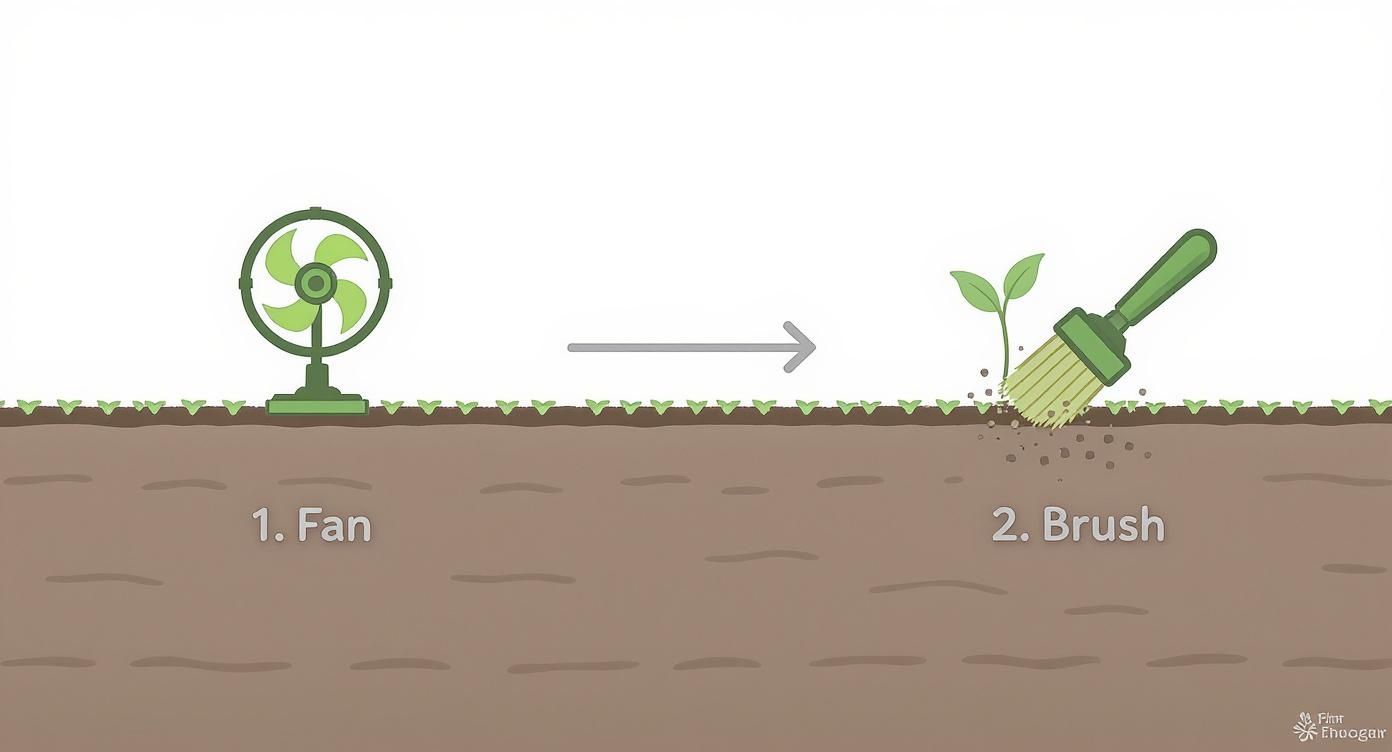
As you can see, simple things like a gentle breeze from a fan or even just brushing the tops of the plants with your hand a few times a day can trigger a response that makes the stems thicker and tougher.
When it's time to pot up, doing it right is key. For more detailed steps, check out our complete guide on how to transplant seedlings to make sure the move goes smoothly. Careful repotting is your final, most powerful tool for fixing leggy seedlings and setting them up for a successful season.
7. Know When It's Time to Start Over
Sometimes a seedling is just too far gone. If the stem is so thin and frail that it's kinked, broken, or can’t stand up at all, even with a little help, it’s probably better to cut your losses and start over. A plant that weak from the get-go will struggle to survive the stress of being transplanted into the garden.
My Personal Rule of Thumb: If a seedling is still standing, it's worth the effort. If it has completely collapsed and looks more like a wet noodle than a plant, I call it a learning experience and sow a new seed.
8. Understand Different Plant Growth Habits
Ever looked at a seed tray and wondered why your zucchini is reaching for the stars while the peppers right next to it look perfectly compact? This is completely normal, and it usually boils down to a couple of things.
- Plant Type: Some plants are just genetically programmed for explosive growth. Think about vining plants like cucumbers and squash—they are built to shoot up and start climbing.
- Germination Speed: The early birds catch the worm, and in this case, they might also start stretching first. Seeds that germinate faster might pop up and start searching for light while their slower tray-mates haven't even broken through the soil yet.
This is exactly why checking on your seed trays every day is so important. Learning to respond to the unique needs of each plant variety is what takes your seed-starting game to the next level.
9. Believe That Leggy Seedlings Can Be Saved
Can leggy seedlings really be saved? Absolutely! In most situations, you can definitely save them. Seedlings are surprisingly tough, especially if you spot the problem early on.
By giving them stronger light, getting some air moving, and burying the stem deeper when you repot (this works wonders for plants like tomatoes), you can often nurse a weak, stretched-out seedling back to health. The goal is to turn it into a sturdy, productive plant, and it's totally possible.
The real trick is to act fast. A seedling that’s just beginning to stretch has a fantastic chance of recovery. One that's already flopped over and can't hold itself up is a much tougher case.
At Homegrown Garden, we believe anyone can grow their own food and flowers with a bit of know-how. Explore our collection of heirloom seeds and all-in-one grow kits to get your garden started. Find everything you need at https://www.homegrown-garden.com.

